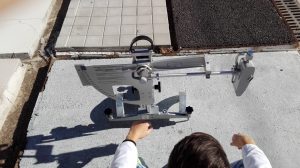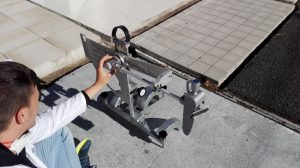Testing the slip resistances
Floor slip resistance testing is the science of measuring the coefficient of friction (or resistance to slip accidents) of flooring surfaces, either in a laboratory (before or after installation) or on floors in situ. Flooring is tested using a tribometer (floor slip resistance tester) to discover if there is a high propensity for slip and fall accidents on it.
In this case, the used device has been the pendulum. The pendulum uses a standardized piece of rubber, which is set up to travel across the flooring sample for 123-125mm, mounted onto the pendulum foot. When the arm of the pendulum is set up to miss the flooring completely, the arm swings up to parallel from where it started, and the pointer (brought along by the arm holding the rubber slider) reads zero. Slippery flooring produces readings close to zero, and flooring which show higher resistance to slipping give results further from zero—high numbers (such as those 36 and above) indicating suitable slip resistant flooring.
Then, data are compared with the tables 1.1 and 1.2 from CTE (Código Técnico de la Edificación) DB SUA.





